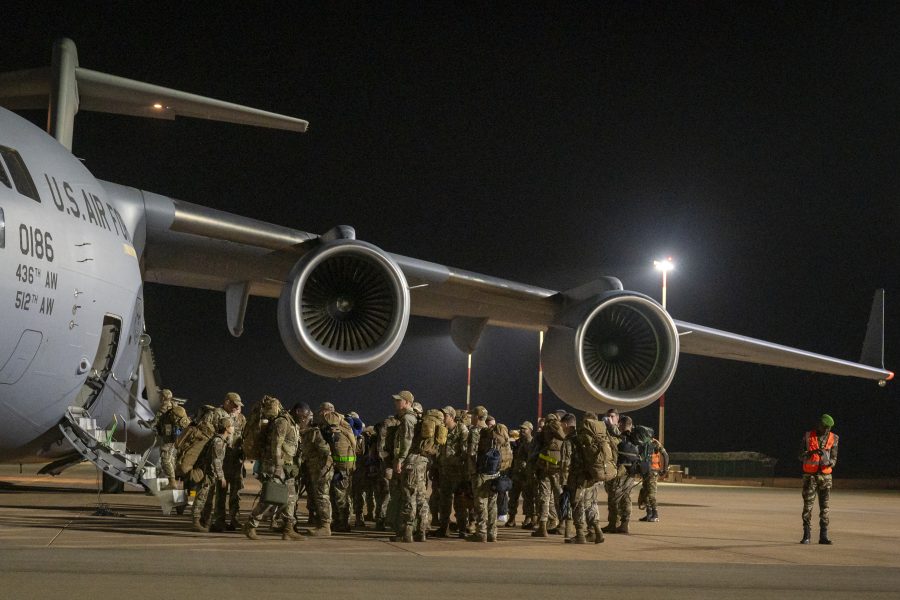NATIONAL HARBOR, Md.—The Space Force used commercial satellite services to support the withdrawal of U.S. forces from air bases in Niger this summer, Chief of Space Operations Gen. B. Chance Saltzman said Sept. 17—a key milestone in the service’s efforts to integrate commercial capabilities into operations and dig deeper into space-based intelligence, surveillance and reconnaissance.
Saltzman highlighted the effort during a keynote address at AFA’s Air, Space & Cyber Conference here as he described the successes of the Tactical Surveillance, Reconnaissance, and Tracking (TacSRT) “pathfinder” program.
TacSRT functions as a marketplace from which the Space Force can buy tactical information from commercial providers to support combatant commanders. In speeches over the last 18 months, Saltzman has noted how the program has supported natural disaster responses across Africa, South America, and Asia; in his keynote, he said it provided “timely analysis of suspicious activities by violent extremists along the border of Rwanda and the Democratic Republic of Congo.”
Yet it was the withdrawal of troops from Air Base 201 in Niger that “stands out the most,” said Saltzman.
“In August, throughout the withdrawal, the team maintained overwatch of everything within 5 kilometers of the base,” he said. “On average, the timeline from collection on orbit to delivery into the hands of security forces was about three-and-a-half hours, but the team got it down to as little as one-and-a-half hours from collection to the security forces by the end of the event.”
Two U.S. air bases in Niger served as critical hubs for missions targeting extremist groups in the volatile region, but the Pentagon withdrew its forces after a military junta overthrew the elected Nigerien government in July 2023. Amid widespread unrest, the Space Force was able to monitor the situation in an area where situational awareness was limited for forces on the ground, Saltzman said.
“What the TacSRT pilot program does is, we simply ask a question into the marketplace: ‘Hey, what generally does it look like around Air Base 201?’” Saltzman told reporters after his keynote. “Are there any items of interest, trucks that are massing? Is there a huge parking lot? Do we see people milling around? We simply ask the question. And commercial industry provides us products that try to help us answer the question.”
Providing that information to security forces to ensure the withdrawal proceeded smoothly and safely is “just proof positive that space makes a difference and makes the joint force better,” Saltzman said.

Space-Based ISR
The Space Force is eager to use more commercial satellites and systems, with leaders saying it will allow them to gain and field capabilities faster than they could build themselves with limited resources. In particular, the service’s first Commercial Space Strategy ranked TacSRT fourth on a list of mission areas where the Space Force would seek to create “hybrid” architectures of military and commercial systems.
Now that TacSRT has proven it offers operational value, the question is how the Space Force will expand and fund it. Congress added $40 million for the program in fiscal 2024, and lawmakers are now debating over the level of funding for 2025.
Included in that debate are questions over the roles of the Space Force and the intelligence community. The House Appropriations Committee directed in its proposed budget bill that the Space Force and the National Geospatial-Intelligence Agency coordinate their efforts to avoid duplication, while giving the NGA director the ability to provide lawmakers with regular assessments and recommendations for the TacSRT program.
The Senate Appropriations Committee, for its part, wants to renew the program’s funding at $40 million.
Saltzman indicated that he was unconcerned about the TacSRT program stepping on any toes, saying in his keynote that it is meant “to complement the exquisite work done by the intelligence community.” Both he and Col. Richard Kniseley, the head of Space Systems Command’s Commercial Space Office, told reporters that the program is not buying imagery, but rather “operational planning products.”
TacSRT also does not provide targeting information, Saltzman noted—the Space Force and the National Reconnaissance Office are working on a separate program to deploy targeting satellites.
“It’s taking the data that’s already available, procured through the NRO and some of it through the NGA, and getting the commercial analytics to make sense of it and to figure out some pattern movements, if you will,” Kniseley said during his own media roundtable.
In that sense, Saltzman said, the program is almost akin to “surveillance as a service.”
Commercial satellite imagery has proven to be a lucrative market for everything from environmental monitoring and forecasting to disaster response, areas where the U.S. military is often called upon for help. The Pentagon wants to shift some of its own surveillance and reconnaissance enterprise for tracking threats to space as well.
